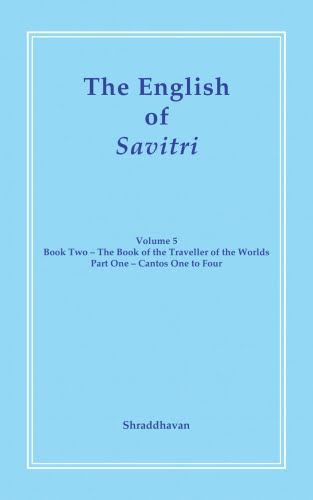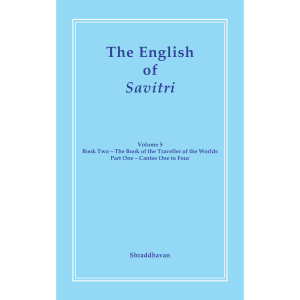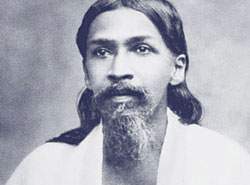The English of Savitri Volume 5

The English of Savitri
volume 5
This is the fifth volume of the English of Savitri series based on transcripts of classes led by the author at Savitri Bhavan, in this case from 6 January to 11 August 2011. The transcripts have been carefully revised and edited for conciseness and clarity, while aiming to preserve the informal atmosphere of the course. This volume contains detailed explanations of the first four Cantos of Book Two, The Book of the Traveller of the Worlds. Each sentence is examined closely and explanations are given about vocabulary, sentence structure and imagery. The aim is to assist a deeper understanding and appreciation of the poem which the Mother has characterised as ‘the supreme revelation of Sri Aurobindo’s vision’.
Author: Shraddhavan
Print Length: 302 pages
Publisher: Savitri Bhavan
Book format: PDF, ePub, Kindle
Language: English
Book Download
Table of Contents
Introduction
Canto One – The World-Stair
- Section 1, lines 1-102
- Section 2, lines 103-238
- Section 3, lines 239-256
Canto Two – The Kingdom of Subtle Matter
- Section 1, lines 1-149
- Section 2, lines 150-359
- Section 3, lines 360-440
Canto Three – The Glory and the Fall of Life
- Section 1, lines 1-90
- Section 2, lines 91-155
- Section 3, lines 156-244
- Section 4, lines 245-440
- Section 5, lines 441-538
Canto Four – The Kingdoms of the Little Life
- Section 1, lines 1-110
- Section 2, lines 111-150
- Section 3, lines 151-200
- Section 4, lines 201-349
- Section 5, lines 350-523
- Section 6, lines 524-671
Supplement – Brief Summaries of Cantos Five to Fifteen
Afterword
Book Sample
The English of Savitri
volume 5
Canto One
The World-Stair
We are embarking upon the second Book of Savitri, ‘The Book of the Traveller of the Worlds’. The Traveller of the Worlds is the rishi-king Aswapati. In Book One we read about his great aspiration to find a power that would be able to bring down the wonderful spiritual realities which he experienced on higher planes and establish them in the material world. He was looking for a highest power of transformation that would be able to achieve that. In response to his intense aspiration he was shown that this physical world is not the only world, that there are subtle worlds; and as he advances on the path he can not only see those subtle worlds, but enter into them. The last sentence of Canto Five of Book One tells us:
A voyager upon uncharted routes
Fronting the viewless danger of the Unknown,
Adventuring across enormous realms,
He broke into another Space and Time.
Aswapati has become able to enter a Space and Time that is different from those that we experience here in the material universe, a subtle Space and Time. In this way he becomes ‘A voyager upon uncharted routes’: there are no maps for the journey that he is embarking upon now: it has never been ‘charted’. In the great days of the exploration of the earth explorers and mariners went into new territory and prepared charts, drew maps of what they had found, so that those who came after them could find their way more easily. But the one who goes first is always travelling on ‘uncharted routes’. So Aswapati does not know what he is going to find on his journey, he is facing the ‘Unknown’, facing danger that he cannot foresee, which is ‘viewless’: he has no view of the dangers that may be lurking there in the ‘Unknown’. He is setting off on an enormous adventure of exploration, ‘Adventuring across enormous realms’ in a much vaster Space and Time than those of our limited material universe. Now we shall begin to follow the Traveller of the Worlds on the journey which Sri Aurobindo has depicted in the fifteen cantos of Book Two, giving us a map of the subtle planes and worlds of existence which lie beyond the material universe we inhabit, of which our human scientists have begun to give us some glimpses. He will show us how those subtle planes and worlds are connected to each other and how they influence our lives here in the human world. But first he gives to us and to Aswapati a vast overview of the many levels of the manifestation.
Alone he moved watched by the infinity
Around him and the Unknowable above.
All could be seen that shuns the mortal eye,
All could be known the mind has never grasped;
All could be done no mortal will can dare.
A limitless movement filled a limitless peace.
Aswapati is all alone, moving in that other Space and Time; he feels that he is being watched, by all the ‘infinity’, all the limitlessness of the new Space and Time which is surrounding him, and by an ‘Unknowable’ reality that is above. In some way, Aswapati can know this new Space and Time that he has moved into, but above that ‘infinity’ lies the ‘Unknowable’. Sri Aurobindo tells us that the ‘Unknown’ is not ‘Unknowable’: many things are unknown to us and we can gradually expand what we know, we can expand our knowledge and our sense of identity and know many new things directly or indirectly; but beyond everything that can be seen and experienced lies a Reality which will remain forever mysterious: the ‘Unknowable’. Aswapati feels that mysterious something or someone watching him as he is moving there in that vast Space; and because he himself has reached such a high level of consciousness, he is able to see everything ‘that shuns the mortal eye’. To ‘shun’, means ‘to turn away from’, ‘to reject’ or ‘to avoid’. There are certain things that we ‘shun’. We try to shun pain; we do not want to experience it. Here the poet says there are many things that avoid being seen by the ‘mortal eye’. This word ‘mortal’ means ‘subject to death’. Here in this material world everything is ‘mortal’, subject to death; but very often we use the word as meaning simply ‘human’. Now Aswapati has entered a state where ‘All could be seen that shuns the mortal eye’, so that he can see many things which hide themselves from our physical eyes, and he becomes able to know all that ‘the mind has never grasped’. To ‘grasp’ means to ‘catch hold of’, to ‘seize’. Our minds are always trying to grasp things, to know and understand them, but in the vaster subtle universe there are many things that cannot be grasped by the mind, they have to be known in another way. Now Aswapati is experiencing great new possibilities, seeing what our death-bound eyes cannot see, knowing things that the human mind has never grasped, and he also feels a new power in him, so that ‘All could be done’ that ‘no mortal will can dare’. Courage is needed to do anything which seems to be at the limit of our capacities, and human beings do use their will-power to respond to challenges that demand great courage; yet however courageous the human will may be, there are certain things which we just do not have the strength to dare with our limited capacities. But Aswapati has moved into a Space and Time where ‘All could be done no mortal will can dare’. His experience is of ‘A limitless movement’: there is no end to what is moving there, but at the same time there is ‘a limitless peace’ – the movement and the peace are both endless.





Leave a Reply
Want to join the discussion?Feel free to contribute!